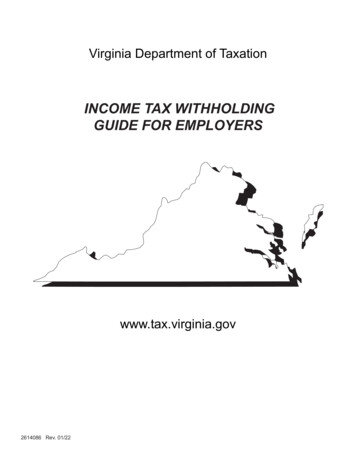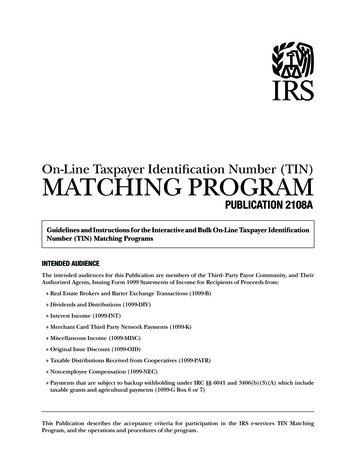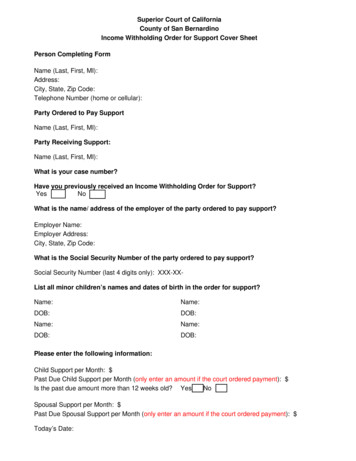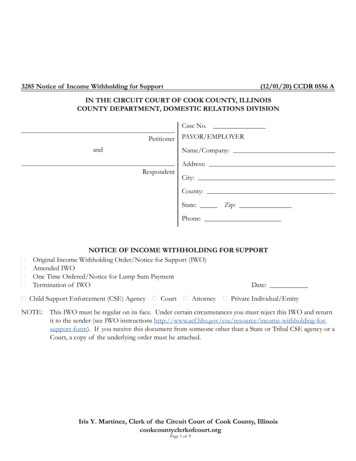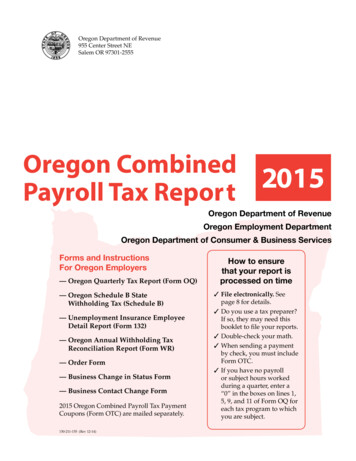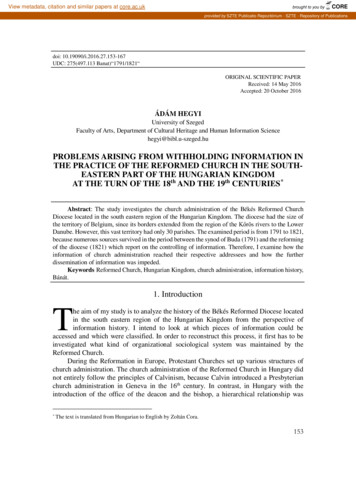
Transcription
View metadata, citation and similar papers at core.ac.ukbrought to you byCOREprovided by SZTE Publicatio Repozitórium - SZTE - Repository of Publicationsdoi: 10.19090/i.2016.27.153-167UDC: 275(497.113 Banat)“1791/1821“ORIGINAL SCIENTIFIC PAPERReceived: 14 May 2016Accepted: 20 October 2016ÁDÁM HEGYIUniversity of SzegedFaculty of Arts, Department of Cultural Heritage and Human Information Sciencehegyi@bibl.u-szeged.huPROBLEMS ARISING FROM WITHHOLDING INFORMATION INTHE PRACTICE OF THE REFORMED CHURCH IN THE SOUTHEASTERN PART OF THE HUNGARIAN KINGDOMAT THE TURN OF THE 18th AND THE 19th CENTURIES *Abstract: The study investigates the church administration of the Békés Reformed ChurchDiocese located in the south eastern region of the Hungarian Kingdom. The diocese had the size ofthe territory of Belgium, since its borders extended from the region of the Kőrös rivers to the LowerDanube. However, this vast territory had only 30 parishes. The examined period is from 1791 to 1821,because numerous sources survived in the period between the synod of Buda (1791) and the reformingof the diocese (1821) which report on the controlling of information. Therefore, I examine how theinformation of church administration reached their respective addressees and how the furtherdissemination of information was impeded.Keywords Reformed Church, Hungarian Kingdom, church administration, information history,Bánát.1. IntroductionThe aim of my study is to analyze the history of the Békés Reformed Diocese locatedin the south eastern region of the Hungarian Kingdom from the perspective ofinformation history. I intend to look at which pieces of information could beaccessed and which were classified. In order to reconstruct this process, it first has to beinvestigated what kind of organizational sociological system was maintained by theReformed Church.During the Reformation in Europe, Protestant Churches set up various structures ofchurch administration. The church administration of the Reformed Church in Hungary didnot entirely follow the principles of Calvinism, because Calvin introduced a Presbyterianchurch administration in Geneva in the 16th century. In contrast, in Hungary with theintroduction of the office of the deacon and the bishop, a hierarchical relationship was*The text is translated from Hungarian to English by Zoltán Cora.153
created and the involvement of secular elements into the church administration wasopposed. The congregation became the main institution of the grass-rooted church in theHungarian Reformed Church as well; however, for historical reasons, the independence ofthe parishes was restricted by the dioceses and the church districts. Obviously, thisrestriction could not be compared with the centralised organization of the Catholic Church.From the 17th century the puritan and Presbyterian movements intended to involve secularsinto the church administration, but the landlords opposed the participation of serfs in thechurch administration. Nevertheless, in the 18th century and especially after the CarolinaResolutio had come into effect, the influence of the seculars in the Church strengthenedbecause the Reformed Church could realize its interests only by the support of wealthynobles. Thus, the office of deputy was created and the convents became regular, becausethe synod could not convene officially. The convent was originally a meeting of secularsheld on a noble estate, where the conveners consulted about aiding the church. However,after a while it became a leading organ of church administration. In 1791 with the electionof Miklós Sinai as a bishop the clash of interests between secular and ecclesiastic peopleintensified. During the debate between the supporters of purely religious leadershiphierarchists were defeated against the secular expansion (kyriarchists). By the beginning ofthe 19th century the Calvinist church administration developed completely into a sharedchurch administration of laymen and pastors, while the hierarchical system ofadministration remained unchanged. The administrative structure established in 1791 hadremained in effect on the territory of the Kingdom of Hungary until 1881. 1In my study I investigate in detail one of the mid-level institutions of the Reformedchurch administration, the Békés Reformed Diocese. The examined period is from 1791 to1821, because the period between the synod of Buda (1791) and the reframing of theterritory of the diocese (1821) is particularly worth looking at from the perspective of churchadministration, because the role of seculars in church administration was consolidated inthis period. Before going into the analysis in detail, it is worth looking at the flow ofinformation in the early modern administration system of the Reformed Church. The basiccriterion of the Calvinist church organisation is the practice of religiosity in congregation,therefore, in spite of the hierarchical system, the structure of the church was only slightlycentralized. Generally, the bishop as the leader of the church district gave instructions to theleaders of the dioceses, the deacons, who forwarded them to the pastors, who in turn led theparishes. Thus, the official channel of information was multistage, while the informalnetworks of communication showed a markedly different form. A good example for this isthat the pastors had a direct relationship to the church district. From the perspective oforganizational sociology, this system was not effective, but it did not collapse either,because it was not dismissed even after Act XXXI of 1715 and the Carolina Resolutio hadbeen passed. 21Molnár 1995: 269–274. The importance of Miklós Sinai’s activity has been discussed in a monograph by ImreRévész. Therefore, I only draw attention to the fact that his person was indispensable because his election as abishop initiated the change of the administrative structure of the Reformed Church that has been going on sincethen. Révész 1959.2 Both of these acts aimed at incapacitating the Protestant churches. Szabó 2004: 79–82.154
2. A few remarks on information historyThe methodology of information history mostly focuses on how a given piece ofinformation influenced historical events. The literature on the topic very often places anemphasis on reconstructing changes in collective knowledge, because this provides aninsight into what extent and why a certain piece of information was important to a society.For example, during the California Gold Rush scholars compared information found innewspapers and guidebooks with the information being spread in marketplaces and throughprivate conversations. This way, researchers managed to reconstruct what kind ofpreliminary knowledge gold diggers had with regard to gold mines. 3Such and similar trends of research are relatively scarce, so it is not surprising that thehistoriography of communication history abounds in debates, which concern the extent towhich the history of information and its reception can be studied as an independent field ofhistorical research. 4 According to prevailing public opinion, histories of the library,censorship or the media are intertwined with the history of the formation of an informationsociety in several ways. I think in the case of information history definite, sharp lines couldnot be drawn between the various historical disciplines, since, for example, the history ofadministration deals with the history of communication networks and information flow atthe same time. Therefore, in the following, I do not intend to reconstruct the operation ofthe Békés Reformed Diocese, but rather to look at how certain pieces of information couldhave been possibly withheld or disseminated in the deaconry. Accordingly, my papermerges perspectives of information history, church history, cultural history and history ofadministration respectively.3. Research aimsIn 1787 the Reformed Church of Hódmezővásárhely was examined by the churchdistrict, because they retained some information from the bishop. The main point of the casewas that some people from the congregation would have liked to remove the pastor fromhis position. To do so, invoking the alcoholism of the pastor’s son seemed to be an expedientpretence, which reflected badly on the pastor. The diocese was partly misinformed by boththe pastor and the congregation, because neither of them wanted to reveal the whole truth.It was precisely the reason why the diocese impeached the congregation, namely, becausethe actual situation could not be clearly seen. 5Due to the Edict of Tolerance and Act 26 of 1791, the situation of the Lutheran andReformed churches improved considerably in the Hungarian Kingdom, because, incompliance with these acts, the church administration got rid of Catholic control: the ‘grandold enemy’ could no longer have a sway over the administration of Protestant churches andthe Protestants were free in the offering of the sacraments and in church visitations.3Stillson 2008.Karvalics 2012; Weller 2008; Weller 2010.5 TtREL I.29.i.67. nr. 10b, Másolat Hódmezővásárhely és az egyházkerület között zajló levelezésről, 1787. [A copyof the correspondence between the parish of Hódmezővásárhely and the church district, 1787.]4155
Moreover, after 1781 the administration of documents was not supervised by the CatholicChurch either. Because of this, Protestant church administration was revived since it couldfreely organise its everyday affairs. 6I examined the information withheld or publicised in the Békés Reformed Diocese asfollows: first, I surveyed the entire existing archival material of the diocese and then Iselected those cases in which the recorder of the document called attention to a lack ofinformation or the recorder intended to make the content of the document known to a widerpublic. Those cases in which the lack of information was not revealed for the recorder weredisregarded because, in order to get a relevant image, those secrecies or disseminations wereimportant which became known to the leaders of the diocese. Therefore, those documentsthat contain instructions about the information that could be found in them are worthinvestigating.In order to be able to offer an accurate examination, first one has to be familiar withthe contemporary documentary system and administrational structure of the diocese.Second, I present the revealed sources divided into two groups containing public or secretinformation. After reviewing the documents it is possible to decide what kind of methodwas applied for concealment or disclosure: through the official channels of the diocese orin an informal way. Simultaneously, one can also ascertain to what extent concealment ordisclosure was successful.4. The Békés Reformed Diocese between 1791 and 1821The Békés Reformed Diocese was located in the region delimited by the Kőrös rivers,the Tisza River, the Lower Danube and the Carpathian Mountains. It united Calvinists livingin Békés, Csanád, Csongrád, Arad, Torontál and Temes counties as well as in the militaryborder zone into one administrational unit. Calvinists living in this region mostly lived invillages and towns, and parishes were not established in larger towns in the examinedperiod: the congregations of Arad, Temesvár (Timişoara) and Nagybecskerek (Zrenjanin)were all formed after 1821. The history of the diocese goes back to the Age of Reformation,but it was eventually established in 1734 in accordance with the Carolina Resolutio. At thistime, the diocese consisted of 22 parishes. 7The coming into force of the Edict of Tolerance and the XXVI Act of 1791fundamentally changed the status of the Reformed Church: Catholic suppression graduallylessened and the Reformed Church started to prosper. The unsuccessful war of Joseph IIagainst the Turks had repercussions on the diocese as well, since many parishes lay close tothe location of the fights. After the peace treaty, the situation returned to normal and untilthe modification of the borders of the diocese in 1821 it continuously improved. 8The diocese was growing in the examined period, because numerous new parisheswere formed. One part of them was organised by Protestants who settled in the Bánát, whilecongregations were founded as gardener settlements. In 1821 the Békés Reformed Diocese6Bucsay 1979: 77–80.; Zoványi Vol. II.2004: 109–130.; Körmendy 2009: 266.Barcsa 1908: 86. Milleker 1925: 77–78, 92–94.8 Ingrao 2000: 211. Kis 1992: 79–81. Vocelka 2000: 202.7156
consisted of the following parishes: Ágya (Adea), Battonya (Batanja), Békés, Békéssámson,Békésszentandrás, Bélzerénd (Zerindu Mic), Borossebes (Sebiş), Doboz, Erdőhegy(Chişineu-Criş), Feketegyarmat (Iermata Neagră), Gyoma, Gyorok (Ghioroc), Gyula(Giula), Gyulavári, Hódmezővásárhely, Kispereg (Peregu Mic), Köröstarcsa, Liebling,Magyarittebe (Novi Itebej), Makó, Mezőberény (Maisbrünn), Nagyzerénd (Zerind), Öcsöd,Pankota (Pâncota), Reformátusdombegyháza, Reformátuskovácsháza, Rittberg(Végvár/Tormac), Szentes, Torontálvásárhely (Debeljača), Vadász (Vânători), and Vésztő. 95. The administration of documentsand church administration in the Békés Reformed DioceseIn the examined period the Békés Reformed Diocese incorporated the reformedChristians of several counties from the Kőrös valleys down to the Bánát. The tract coveredan area of such extension, as in the early 19th century more and more Calvinist settlers’villages were established in the Southern Region. 10 Large geographical distances hinderedthe administration of the diocese, which is perhaps best shown by the minutes of visitationreports and the list of participants on diocesan meetings. The deacon never appearedpersonally on the settlements of Bánát (Rittberg, Liebling, Torontálvásárhely,Magyarittebe, etc.), but the visitation was performed by one of the sheriffs from Temescounty and a church pastor or an assessor. For similar reasons, the diocesan meetings werenever held in the Bánát and the pastors living in that region hardly ever appeared personallyin front of the leadership of the diocese. Furthermore, Torontálvásárhely was located in amilitary border zone where the military administration often intervened into ecclesiasticaffairs as well. 11It is known that during the history of the Hungarian Reformed Church the diaconaloffice was established as a so-called mobile office. This meant that the head of the tract hadno permanent seat, but the archives of the diocese were always transported to the settlementwhere the pastor served as deacon. 12 In addition to making the contents of the archives veryvulnerable, it also meant that an extensive amount of documents could not be generatedduring the centuries, since it would have been difficult to transport them. In 1762 thepractice of records management of the dioceses was regulated in detail. This stipulated thatminutes should be written on the meetings of the tract and that a separate protocol had to beintroduced on the questions asked during the church visitations. 13 The 9th canon of the Budasynod (1791) also prescribed the management of minutes and it called the attention of thedeacons in particular to elaborate archival regulations in the diocesan archives.14Additionally, the deacons were required to prepare an annual written report to the dioceseon what happened in that year in the diocese, but the preparation of these reports was usually9Kis 1992: 85–91.Kis 1992: 79–81.11 Barcsa 1908: 84, 122. TtREL I.29.a.2, Egyházmegyei közgyűlés, Hódmezővásárhely, 1787. február 1. [Generalassembly of the diocese, February 1, 1787, Hódmezővásárhely]12 Molnár 1995: 269–274.13 Tóth 1964: 68.14 Révész 1860: 58–62.10157
sabotaged by them. 15 They could probably do so because the church was not organisedenough to sanction this regulation.It was also included in the canons of the Synod of Buda that the dioceses were requiredto implement the instructions of the church district, which meant that they regularly gotcircular instructions from the bishops, the principal clerk or from the generalsuperintendent. 16 Managerial tasks demanded the preparation of other written documents,too; thus, for instance, the deacon sent circular instructions to the pastors. What is more, heled the so-called diaconal diary about the daily affairs and the leaders of the congregationskept correspondence with the deacon, who also made submissions, reports and complaintsabout the contentious issues. 17The archives of the Békés Reformed Diocese were established at the end of the 19thcentury by Sámuel Szeremley, but the archival system he created was dismissed as it wasmerged into the Archives of the Trans-Tisza Region (Tiszántúl) Church District. 18 On thebasis of my experience I can state that the deacons of the diocese did not establish anyarchival regulation or order between 1791 and 1821. They only numbered the cases in theminutes, but the documents belonging to them were not provided with archival notes. Thelack of archival order is also shown by the fact that they endeavoured to systematise thedocuments in 1812 unsuccessfully. 19 Apart from the documents pertaining to diocesemeetings or diocesan visitations, diaconal diaries and reports, no other regularly writtendocuments were compiled in the Békés tract.Fortunately, the reports of the general assembly of the diocese and the protocols of thechurch visitations still exist. 20 However, diaconal diaries were only being written from1816. 21 According to the testimony of the sources, complaints occurring in thecongregations were examined during church visitations. If they could not be solved locally,they were discussed at the diocesan assembly. Submissions and complaints written duringthe visitations were mostly lost; now only the records of reports on the differences ofopinion can be found. In addition to them, circulars and documents separately administeredby the deacon survived. Circulars were issued by the organs of the church district, thecouncil of governor general and the counties, while rather heterogeneous documents can befound among the material dealt with by the deacon: complaints against priests,denunciations, diaconal circulars, summary reports on sins committed by the members ofthe congregation, etc. 2215Barcsa 1908: 122.Révész 1860: 58–62.17 Molnár 1989: 328–333.18 Sámuel Szeremley was a pastor and historian in Hódmezővásárhely, who published several works on the historyof the Reformed Church.19 It was noted during the assembly of the diocese held in Hódmezővásárhely on 25 May 1812 that the archiveswere much disorganised and the assembly ordered the deacon András Kis and Ferenc Nagy to systematicallycatalogue it, which, however, they did not do. Kis 1992: 157. Another unsuccessful endeavour to systematizethe archival material was attempted in 1818. TtREL I.29.c.16. nr. 58., Egyházkerületi közgyűlés jegyzőkönyvikivonata, 1818. október 3–5. [The resume of the general assembly of the district, 3–5 October 1818]20 TtREL I.29.a.2.; TtREL I.29.h.1.21 TtREL I.29.o.1.22 TtREL I.29.f.3.; TtREL I.29.c.16158
The revised documents revealed that the way of the information spreading or its lackin the diocese can be reconstructed on the basis of the minutes of the diocesan assembly,but valuable data were also revealed from the documents handled separately by the deacon.6. The official way of the spread of informationSince the communications network of the diocese was regulated by the laws of theReformed Church, it is worth examining how the official structure was built up, and howthe informal system worked. Being acquainted with the system one can conclude on howthe information could be concealed and to what extent the spread of the information throughofficial ways was effective.The organization of the diocese was regulated by various religious laws. In theexamined period the canons of the Buda synod were the guiding provisions, in spite of thefact that, due to the absence of the royal assent, they never entered into force. Practice,however, shows that their influence can be clearly demonstrated, because from this pointon the Presbyterian system of administration became widespread in the Church. 23 Besidethe canons of the Buda synod, the canons of Geleji or Zoványi synods and the decisions ofchurch visitations from 1762 were also used in the Trans-Tisza Region (Tiszántúl) ChurchDistrict. As opposed to the decisions of the Buda synod, they tried to dwarf the role of thelaymen in church administration, but they show many similarities in those fields that pertainto the diocese.On the basis of the above mentioned arguments, it can be claimed that the leader ofthe diocese was the deacon and the laic superintendent. The deacon, the superintendent andthe assessors together constituted the decision-making body of the diocese, the consistory.Assessors were selected in equal numbers from laymen and ecclesiasticals. In special casesthe delegate of the parish could also be elected as the member of the consistory with thepermission of the church district and in these cases a delegate could represent more churchessimultaneously, too. The president of the diocesan consistory was the deacon and thesuperintendent. The deacon decided in religious matters, while in other cases thesuperintendent’s vote determined the decision. 24The consistory usually convened twice a year in the Békés diocese and in the periodbetween the meetings the deacon administered the daily affairs. Church visitation wasregularly practised, on which occasions they had the opportunity to deal with the affairs ofchurch administration as well. In the examined period the diaconal position wascontinuously filled, while data on the activity of the laic superintendent were available onlyfrom 1795. The number of the assessors was between 5 and 7 on average, among whom laicand ecclesiastical people could be found alternately. However, it had been unprecedentedthat a pastor or a member of a congregation would receive the right to vote in theconsistory. 25 On the basis of this, it can be argued that the official system of dioceseadministration was conducted through the church visitations and the diocesan meetings. The23Révész 1891.Tóth 1964: 4–5; Barcsa 1908: 47; Szentpéteri Kun 1948: 80.25 TtREL I.29.a.2.24159
unofficial administration was carried out among the congregations and in some cases itcould be observed between the congregations and the deacon. The latter was the case when,for example, a decision was made in a diocesan affair without the approval of the deacon orthey intended to influence a consistory decision by providing false information: theywithheld notes or did not appear in front of the deacon, etc.After reviewing the tract’s customs of administering the documents and theorganizational structure of the tract, it is worth looking at what kind of sources could befound with regard to withholding or disseminating information. First, those documents areinvestigated which aimed to transmit their inherent data to more and more people.7. Public informationWritten information basically spread in hand-written documents, because the smallnumber of local printing-houses did not make it possible to disseminate quicklyreproducible documents. In the examined period there was no working printing house in theBékés Reformed Diocese, the closest printing houses were in Szeged, Arad and Temesvár.26The preserved sources testify that it was important to try to spread the important publicinformation for the diocese more effectively and more quickly than before. For example, itwas essential to organize church services as soon as possible on the occasion of the deathof Leopold II in all churches, because the Reformed Church intended to retain its obtainedfreedom by proving its loyalty to the ruling dynasty. Not surprisingly, bishop FerencHunyadi personally wrote a letter to the deacon Benjámin Szőnyi in which he instructedSzőnyi that on the occasion of the death of the monarch every congregation is obliged tohold service. 27Similarly, it was vitally important that the parishes should be aware of the existingregulations on churches, because prior to the publication of the Edict of Tolerance asettlement’s right of freely practising religion depended on them, but it was also necessaryto know these regulations after 1781 as well. Thus, during church visitations it was strictlyinspected whether the parish had the royal decrees or not. It was even meticulouslystipulated years after 1781 what kind of documents all parishes should have. The diocesanassembly held on February 1, 1787 at Hódmezővásárhely proclaimed that copies of royaldecrees should be delivered from Csongrád, Csanád and Békés counties which they wouldsubsequently send to every congregation and they would also check if they are availableunder the 7th point of the church visitation. 28The need for the quick dissemination of information could also be observed in issuesconcerning the property and institutions of the church. The operation of schools was acentral issue of the Reformed Church, too, since after the proclamation of the RatioEducationis the church had to contend with the centralizing ambitions of the state on a26Szabó 2008: 112. Gaál 2001: 5–10.TtREL I.29.c.12, Hunyadi Ferenc levele Szőnyi Benjaminnak, Debrecen, 1792. március 27. [The letter of FerencHunyadi to Benjámin Szőnyi, 27 March 1792, Debrecen.]28 Kis 1992: 139.27160
regular basis. 29 Therefore, it is not surprising that in 1796 the church district ordered thedioceses to proclaim the new regulations of the state concerning the schools throughout thetract as soon as possible. 30In other cases, the consistory was ready to take into account other documents thanthose prepared in advance in order to facilitate a quick ruling. For example, not all thedocuments were available for the ecclesiastical court in the case of János Darótzi, thedismissed pastor from Erdőhegy. Therefore, the court decided to send a rider to Arad toobtain the documents as soon as possible. 31 A similar case may have occurred at a diocesanmeeting, as Benjámin Hevessy, the town clerk of the city of Szentes, issued an officialcertificate in 1821 on why a letter for the diocesan meeting of Vásárhely did not arrive intime: a local gypsy woman from Vásárhely was sent with the letter, but she did not godirectly to Szentes; instead, she spent a night in a village on her way to Szentes. (Szentesand Hódmezővásárhely are 25 km far from each other, a pedestrian was certainly able tomake this way in a day.) 32In issues concerning the whole diocese circulars were generally sent. In these casesthey did not choose postal distribution, but pastors from geographically close parishes wereasked to forward them. These routes were addressed usually to communities along theMaros and the Kőrös and in this way it was ensured that congregations could inform eachother like a skirmish-line. In 1795 Sámuel Szentmiklósi Sebők definitely chose this way toforward his circular, for which he specifically asked pastors, because next to the addressinghe also detailed the mode of the forwarding of the letter. 33The sources indicate that these pieces of information intended for a larger audienceactually reached the addressees, which was also confirmed by two examples: these circularswere copied into separate minute-books in Szentes, while in Hódmezővásárhely they wererecorded in the proceedings of the presbytery. 34 In the following section the paper discusseswhat kind of information they endeavored to keep secret and what kind of means wereavailable for this purpose.8. Concealed informationAfter the death of Joseph II in 1790 protests intensified against the centralizing policyof the monarch in the Hungarian Kingdom. It was a delicate situation for the ReformedChurch, because the convention of the National Assembly and the preparations for thecoronation created a tense situation, in which the Protestants were interested in maintaining29Bucsay 1979: 90–91.TtREL I.29.a.2., Egyházmegyei közgyűlés, Makó, 1796. március 15–16. [General assembly of the diocese, 1516 March 1796, Makó.]31 TtREL I.29.a.2., Egyházmegyei közgyűlés, Nagyzerénd, 1808. február 10–11. [General assembly of the diocese,10-11 February 1808, Nagyzerénd.]32 TtREL I.29.i.67. nr. 157., Hevessy Benjámin szentesi városi jegyző nyilatkozata. Szentes, 1821. szeptember 25.[The declaration of the town clerk of Szentes, Benjámin Hevessy, 25 September 1821, Szentes.]33 TtREL I.29.c.25., Szentmiklósi Sebők Sámuel esperesi körlevele Szentes, 1795. augusztus 8. [The circular ofthe deacon, Sámuel Szentmiklósi Sebők, 8 August 1795, Szentes.]34 SzNREL I.375.b.1–2. ; HÓRGyL Presbiteri jegyzőkönyv 1795–1806. [Minutes of the presbyter 1795-1806.]30161
the status quo. 35 Not surprisingly, the bishop from the Trans-Tisza Region (Tiszántúl)Church District sent instructions to the deacon, Benjámin Szőnyi, not to disseminate lawssubmitted to the Diet and national political news in the congregations. Instead, they shouldreassure the disgruntled people that there would be no conscriptions and the price of the saltwould not rise. The bishop also emphatically asked that his letter ought to be kept secret. 36Other documents did not mention similar national affairs, but concealing and retaininginformation often yielded quick results. In the case of the late pastor of Makó, MiklósEcsedi, the consistory originally decided to compile a list of his goods. The executors,however, exceeded their competence because they not only registered the pastor’sbelongings, but they also auctioned them. Despite the fact that they violated the diaconalinstructions, they were not convicted, but only reprimanded. 37The deacon repeatedly noticed that the documents he received did not reflect realitybecause the congregation was not interested in telling him the whole truth. For example, fora long time the congregation of Makó refused to submit its complaints concerning thedismissed cantor Mihály Újvári to the deacon, who was thereby incapacitated to arrive at
THE PRACTICE OF THE REFORMED CHURCH IN THE SOUTH-EASTERN PART OF THE HUNGARIAN KINGDOM . AT THE TURN OF THE 18 th AND THE 19 CENTURIES * Abstract: The study investigates the church administration of the Békés Reformed Church Diocese located in the south eastern region of the Hungarian Kingdom. The diocese had the size of the territory of Belgium, since its borders extended from the region of .


